A Comprehensive Guide to Unclogging a Dryer Vent
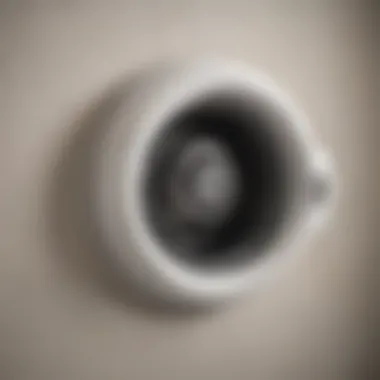
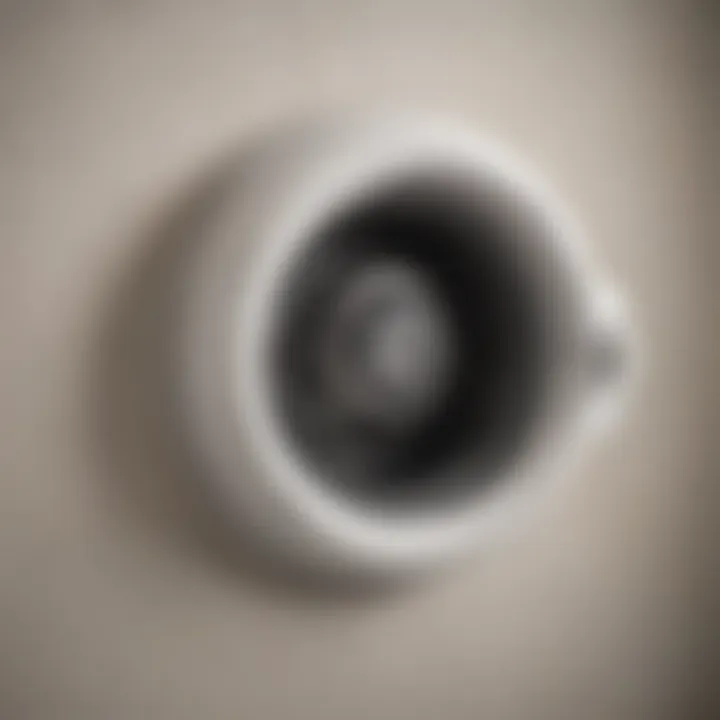
Intro
When it comes to household maintenance, dryer vents often take a backseat in our minds—until things go haywire. If you’ve noticed your clothes taking longer to dry or an unexpected spike in your energy bills, it might be time to check your dryer vent. Neglecting this crucial part of your laundry system can lead to a host of problems, including increased energy costs, lint build-up, and even fire hazards. This guide will delve deep into understanding why it’s essential to keep your dryer vent clean and how to do so efficiently.
After all, a well-functioning dryer vent isn’t just about convenience; it’s about safety and efficiency. But don’t worry, we’ve got you covered, from causes of clogs to preventive measures. Stick around, and let’s unravel the ins and outs of dryer vent maintenance.
Key Insights and Trends
In the world of home care, understanding the current landscape in dryer vent safety can be eye-opening. Here are a few key insights:
- Growing Awareness: Many homeowners are becoming increasingly aware of the potential dangers that clogged dryer vents pose. This knowledge is pushing manufacturers to design dryers with better warning systems and exit pathways to prevent overheating.
- Preventive Measures: More individuals are investing in preventative maintenance services. Regular check-ups can help catch issues before they transform into full-blown problems.
- Eco-friendly Choices: Sustainable practices are also trending. Consider using energy-efficient dryers that come equipped with built-in lint filters that are easier to maintain.
Staying informed about these trends not only boosts your home's safety but also enhances energy efficiency, saving you bucks in the long run. It's essential to stay vigilant and proactive regarding your dryer vent systems.
Common Causes of Clogs
Identifying the sources of dryer vent clogs can prevent a big mess down the line. Here’s what to watch for:
- Lint Build-up: The most prevalent cause is, of course, the accumulation of lint. Over time, tiny fibers from clothes gather in the vent, narrowing the passage.
- Birds' Nests: Sometimes nature has its way; birds love to make nests in vents, creating blockages that can exacerbate existing issues.
- Improper Installation: If the venting system is incorrectly installed involving too many bends or long distances, it can trap air and lint more easily.
Practical Tips and How-To Guides
Keeping your dryer vent clean and free from obstructions is a straightforward task. Here are the practical steps you can take:
Step-by-Step Unclogging Guide
- Safety First: Always unplug your dryer and shut off the gas supply if applicable before you start.
- Gather Your Tools: Go for a screwdriver, a vacuum cleaner with a hose attachment, and a long brush designed for vents.
- Remove the Vent Hose: Detach the dryer vent hose from the wall and dryer. Brace for any dust or lint that may come flying out.
- Inspect the Vent: Check the vent for visible blockages. Look for major lint clumps or nests.
- Use the Brush: Insert the vent brush and clean it thoroughly. Move it back and forth to capture as much lint as possible.
- Vacuum the Area: Follow up with a vacuum to remove any remaining debris from both ends of the vent.
- Reattach and Test: After cleaning, reattach the vent and plug the dryer back in. Run it on air fluff for a few minutes to ensure it’s working correctly.
Preventative Measures
Keeping your dryer vent clean isn’t a one-time effort. Here are some ongoing measures:
- Clean the Filters: Always clean the dryer lint filter after every use.
- Schedule Regular Inspections: Aim for annual inspections to ensure the vent is in good shape.
- Avoid Overloading: Don’t pack your dryer to the brim—overloading can hinder airflow.
"A little maintenance goes a long way in preserving your appliance's life and keeping your home safe."
Regularly maintaining your dryer vent not only ensures your appliance works efficiently but also plays a crucial role in maintaining safety in your home.
Understanding Dryer Vents
When it comes to home maintenance, understanding dryer vents is crucial for homeowners seeking to maintain efficiency and safety within their laundry spaces. A well-functioning dryer vent ensures that moisture and lint quickly exit your home, preventing not only inefficiency but also potential fire hazards. You might think of it as a vital artery in your home’s ecosystem; if it’s clogged, the entire system suffers.
Function and Mechanics
The function of a dryer vent goes beyond just keeping your clothes dry. Essentially, it channels hot, moist air produced during the drying cycle outside your home. This process helps to maintain a consistent temperature within the drum of the dryer, allowing for efficient drying of clothes. If the vent is obstructed, hot air can build up, causing the dryer to overheat and reducing its lifespan.
Mechanically, dryer vents operate on a simple principle: hot air rises. As the dryer operates, the heated air carries moisture away from the clothing, while the venting system directs this air outside. Understanding this flow is vital because any disruption — from lint build-up to foreign objects — can throw a wrench in the entire system.
Common Materials Used
A variety of materials can be found in the construction of dryer vents. Most often, you’ll encounter:
- Rigid Metal Ducting: Generally exhibits the best performance because it is less prone to clogs.
- Semi-Rigid Ducting: This is easier to adjust and can bend to accommodate turns, but can still catch lint over time.
- Flexible Plastic Venting: This is the least desirable option, as it tends to sag and allows lint to build up more easily.
- Hooded Vent Caps: These help prevent downdrafts and block critters from entering the vent; often made from metal or hard plastic.
Choosing the right material is critical for both performance and safety. Rigid metal ducts are typically considered the gold standard due to their durability and ease of cleaning.
Typical Setup in Homes
In most homes, a dryer vent typically runs from the back of the dryer, threading through the wall and exiting outside. Here’s a basic rundown of the common setup:
- Connecting the Dryer: Right at the back, your dryer should have an outlet that attaches to the venting system.
- Sizing the Duct: Ideally, the vent diameter should be around four inches, creating just the right space for efficient air movement.
- Routing through Walls: Many setups take the vent through the home's walls, often dropping vertically or horizontally to reach an exterior wall.
- Exterior Vent Cap: This is the final point where the hot air exits, usually featuring a flap that opens when air is flowing and closes when not in use.
With this setup, it's important to consider any bends or turns in the duct as each one can become a potential trap for lint. When layouts deviate from the straight and narrow, check your connectors and joints regularly to ensure airflow stays clear.
Remember: A clear and efficient dryer vent not only enhances drying performance but also significantly reduces the risk of fire hazards. Regular inspections can save you from costly repairs and ensure a safer home environment.
The Importance of Regular Maintenance
Maintaining a clear and efficient dryer vent system is not just a task on a homeowner's to-do list, it’s a crucial responsibility that holds many benefits. Regular maintenance of dryer vents helps to improve appliance performance, ensure safety, and prolong the life of both the dryer and the vent system. Knowledge of these elements is essential for anyone looking to safeguard their home against potential hazards while also saving some cash on utility bills.
Efficiency and Energy Savings
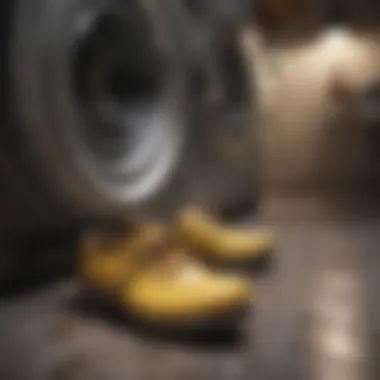
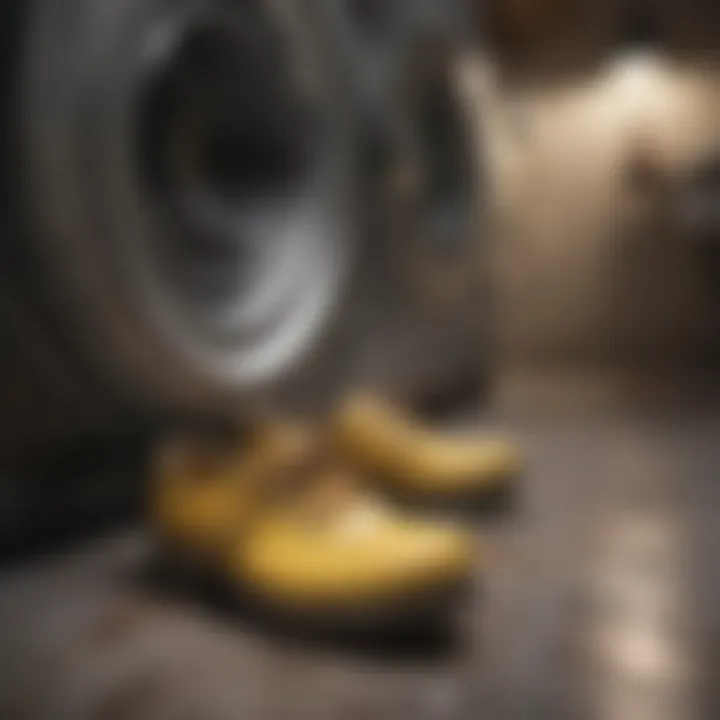
One of the first things that gets overlooked is the efficiency of the dryer itself. When vents are clogged, it puts stress on the dryer, leading it to work harder to send moisture outside. This can translate into longer drying times, often leaving you frustrated as you wait for your clothes to dry. Not to mention the extra wear and tear on the appliance that comes from increased usage.
Moreover, energy savings are non-negligible. A clear vent can help ensure the dryer runs more efficiently, consuming less energy and reducing your utility bills. Over time, the savings can snowball into a substantial amount, making the months of effort completely worth it. The reduction in energy use not only keeps your wallet happy but also has a ripple effect on environmental conservation by lowering energy consumption overall.
"A stitch in time saves nine" is a saying that rings true when it comes to maintaining your dryer vent.
Keeping the vent clean means more than just saving on electricity; it means fewer loads taken in and out of the dryer. A well-maintained dryer vent can save you hassle and frustration while also contributing positively to the environment.
Home Safety Considerations
When you talk about dryer vent maintenance, safety should always be at the top of your list. A blocked vent presents a fire hazard as lint is highly flammable. Statistics show that nearly 2,900 home fires are caused by clothes dryers each year, many of which can be traced back to unclean or poorly maintained dryer vents. These fires risk more than just property damage; they could endanger lives.
In addition to fire risks, a clogged vent can lead to overheating appliances, which can cause irreparable damage. This is another reason why regular inspections and cleaning are a must. It essentially acts as a preventative measure, safeguarding both your family and property from dire consequences. Decreasing fire risks through maintenance means one can sleep a little easier at night, knowing they have taken the right steps.
In summary, implementing a regular maintenance routine for your dryer vent ensures that appliances operate at peak efficiency while significantly reducing potential fire hazards. By keeping your dryer vent in check, you’re investing not only in energy savings but also in the safety and wellbeing of your home.
Common Causes of Clogs
Understanding the common causes of clogs in a dryer vent is a crucial aspect of dryer maintenance. Many homeowners often overlook these factors, leading to significant inefficiencies and even safety hazards. By identifying the root causes of these clogs, you can take appropriate action to prevent them, preserving your dryer’s longevity and safeguarding your home against potential fire risks.
Lint Build-up
One of the most prevalent causes of dryer vent clogs is lint build-up. Lint, a byproduct of drying clothes, can accumulate over time in the venting system. After numerous cycles of drying, the accumulation can reach a point where airflow is severely restricted. When airflow diminishes, it creates a cascade of issues. You might notice clothes taking longer to dry, which could lead to the dryer overheating. This scenario not only stresses the appliance but also raises the risk of ignition, making it a fire hazard.
To combat lint build-up, it’s vital to establish a regular cleaning routine. Using a lint brush or a specialized vacuum attachment can help keep those pesky fibers at bay. Furthermore, the use of dryer balls can reduce lint formation by separating garments as they tumble, thereby enhancing airflow and efficiency.
Foreign Objects
Another issue often revealed in clogged dryer vents is the presence of foreign objects that somehow make their way into the venting system. Items such as small pieces of fabric, socks, or even pet hair can get lodged within the vent. While these items may seem harmless, they can severely disrupt the venting process.
When foreign objects obstruct the lint screen and ductwork, similar consequences occur as with lint build-up: extended drying times, potential overheating, and excessive wear on the dryer. Homeowners should periodically inspect the vent and the surrounding area to ensure no stray items have slipped into the system.
"Regular checks save you time and money! Not to mention, keeping your dryer safe from unfortunate accidents."
Poor Vent Installation
Lastly, the manner in which your dryer vent is installed can play a significant role in the likelihood of clogs. If the vent pipe is too long or is situated at awkward angles, this can create spots for lint and debris to gather. Additionally, using duct tape or non-metallic vents instead of metal ducting might lead to structural integrity issues, further exacerbating the risk of clogs.
Choosing the right venting material and ensuring the installation adheres to local building codes is essential for optimal dryer performance. If you find yourself faced with ongoing vent issues, it may be worth consulting a professional to reassess the installation.
Signs Your Dryer Vent is Clogged
Recognizing signs that your dryer vent requires attention is crucial for maintaining a safe and efficient home. Clogged vents can lead to a series of problems, not just for your dryer but for your entire household. Observing these indicators early can save you from costly repairs, safety hazards, or even worse, house fires.
Extended Drying Times
One of the most evident symptoms of a clogged dryer vent is an increase in drying times. If you find yourself repeatedly running the dryer for multiple cycles just to get your clothes dry, something is off. The lint and debris accumulation in the vent restrict airflow, hampering the dryer’s ability to expel hot air.
So, every time you do a load, did you notice that your laundry is still damp, even though the dryer has been running for what feels like an eternity? This inefficiency not only frustrates but also signals that it's time to investigate the vent system.
- Tip: If you have to keep checking the time and running extra cycles, consider this a red flag. Skipping on ventilation maintenance now could lead to larger issues down the road.
Overheating Appliances
Another glaring sign of vent blockage is when the appliance begins to overheat. A dryer that's running hotter than usual can be dangerous. If you touch the exterior and feel it is abnormally warm or even hot, it could indicate that the machine is working harder due to airflow restrictions.
Why should you care? An overheating dryer is at risk of malfunction. In a more severe scenario, it may catch fire, posing a serious threat to your home and loved ones. Over time, heat build-up affects not just the dryer but can shorten the lifespan of the appliance itself.
- Take Notice: If you hear strange noises as the dryer operates, along with the overheating symptom, it’s high time to check the vent.
Unpleasant Odors
Let's not forget the olfactory warning signs. If you start catching a whiff of mustiness or burning smells when using your dryer, it’s more than just your clothing getting a little too tight—this is a cue that your lint buildup is excessive and potentially igniting. The buildup of lint can trap moisture and become a breeding ground for mildew, resulting in unpleasant odors.
"Ignoring strange smells coming from your dryer may seem harmless, but it’s an essential alert system that shouldn’t be silenced."
Remember, these odors can seep into your clothes, making them less than delightful to wear. If anything, a foul smell could be the universe's way of saying it’s time for a little cleaning before things get out of hand.
Epilogue
Being vigilant about these signs can lead to prompt action, preventing further complications. Extended drying times, overheating appliances, and unpleasant odors all serve as warning bells. Ignoring them could result in not just minor inconveniences but major repairs or safety hazards. Keep your dryer vent clean and clear for a safer and more efficient home.
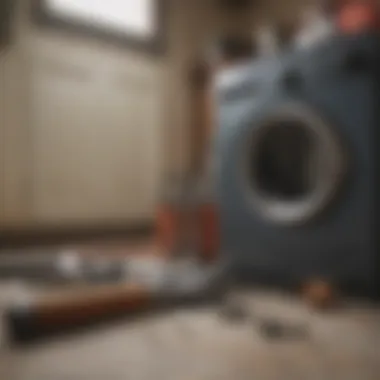
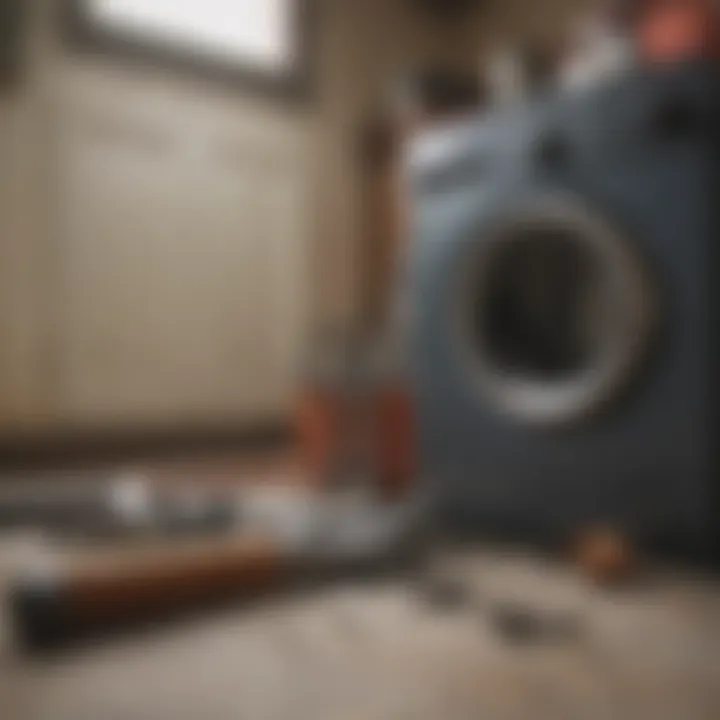
Tools Needed for Unclogging
When it comes to keeping your dryer vent clear, the right tools can make all the difference. Without proper tools, what should be a straightforward job can turn into a real headache. This section outlines the basic cleaning tools and specialized equipment you'll need to tackle any clogs effectively. Having the right gear not only saves time but improves your chances of maintaining the vent in optimal condition, ensuring safety and efficiency in your home.
Basic Cleaning Tools
The first step in unclogging your dryer vent is gathering essential cleaning tools. These tools are your foundation for tackling this task and include:
- Vacuum Cleaner: A powerful vacuum can suck out lint and debris effectively. Look for one with a narrow hose attachment as it will help reach those tight spaces.
- Lint Brush: A lint brush is specifically designed to navigate through vent interiors, dislodging stuck lint that might be causing clogs. They are usually long and flexible, perfect for getting into crevices.
- Screwdriver Set: You'll often need to remove vent covers or brackets, so a quality screwdriver set is crucial. Opt for a multi-bit screwdriver for versatility.
- Flashlight: Visibility is key when working in darker spaces like crawl spaces or behind appliances. A good flashlight or headlamp will help you spot all the trouble areas.
- Bucket or Dustpan: Keep these handy for collecting any debris you manage to pull out of the vent. It helps to have something close by to catch all that mess.
Using basic tools ensures you can confidently tackle minor clogs without calling a professional. However, some situations require a bit more than just elbow grease.
Specialized Equipment
In some instances, especially with persistent clogs, you might need to pull out the big guns. Here are some specialized tools that can help you achieve a thorough clean:
- Vent Cleaning Kit: This kit usually comes with flexible rods and various brush sizes. It's specifically designed to reach deep into the vent system, effectively removing tough and built-up lint. Some kits even have a vacuum attachment feature, allowing you to suck up the debris as you clean.
- Inspection Camera: For those tricky clogs, an inspection camera can provide real-time feedback on what’s going on inside the vent. This tool lets you see blockages without tearing the whole setup apart.
- Blower: In more severe cases, a leaf blower can be adapted for vent cleaning. It creates a powerful airflow that can help push stubborn debris out of the vent. Make sure to secure your system properly as the force might dislodge parts!
- Air Compressor: This is another robust option for those really stuck situations, providing a burst of air that can clear debris. Just be cautious not to damage vent materials.
Using specialized equipment will not only save you time but can also prevent damage to the dryer vent system, avoiding costly repairs later. Always weigh the options and know when it’s best to call in the pros if the clog becomes too daunting.
How to Unclog a Dryer Vent
Unclogging a dryer vent isn't just a matter of convenience; it's a crucial part of home maintenance that can have a direct impact on your safety, efficiency, and wallet. A clear vent system promotes proper airflow, which means your dryer operates effectively, conserving energy and reducing wear and tear on the appliance. Given the potential hazards of lint buildup, knowing how to properly unclog a dryer vent is essential for every homeowner. Not only does it save money on energy bills, but it also minimizes the risk of fire hazards, ensuring your home remains a safe haven.
Safety Precautions
Before diving into the sweat and grime of vent cleaning, it’s imperative to prioritize safety. Safety first isn't just a catchy phrase; it's a guideline that can prevent accidents. Disconnecting power is the single most critical step to take. Always unplug your dryer from the wall to eliminate any risk of electrocution while working. Make sure the area is well-lit and clear of any obstructions that could cause you to trip or fall. Consider wearing a mask; this keeps you from inhaling dust and potential allergens that may have built up inside the vent. Protect your hands with gloves—it's not just about comfort, but also about protecting your skin from scrapes or irritants.
Step-by-Step Process
To unclog a dryer vent, it's better to take a thorough and methodical approach rather than rush through it. Each step contributes not just to solving the problem, but also to improving the overall health of your dryer.
Disconnecting the Dryer
The very first step is disconnecting the dryer. By unplugging the appliance, you ensure no power flows to it while you’re cleaning. This is especially important since it eliminates any risks associated with accidental startups. Moving the dryer away from the wall might feel cumbersome, but it allows you to access the venting system without contortion. Furthermore, it's a good opportunity to clean behind the dryer where dust binds together like old friends, just waiting to cause issues. Also, make sure to check the hose connection, as a loose or damaged hose can contribute to clogging.
Accessing the Vent
Once the dryer is out of the way, accessing the vent comes next. Remove any clamps or screws that are holding the duct in place. This step is often overlooked, but proper access is key. Examine the venting system for any signs of damage or misalignment; even a slight bend can sabotage airflow significantly. Another benefit here is you can inspect the entire path from dryer to exterior, noting any areas that might need extra attention.
Cleaning the Vent
Now, for the heart of the job: cleaning the vent. Using a vacuum with a long hose attachment is often your best bet, as it sucks out lint and debris that has accumulated deep within the ductwork. Alternatively, a dryer vent cleaning kit can be incredibly useful; these kits often come with flexible brushes that reach even the most stubborn corners. When you’re all done, make sure to check if the airflow has improved by feeling air from the outside vent. If it’s blowing freely, rejoice!
Reassembly and Test Run
After cleaning, it’s time for reassembly. This means reconnecting the ductwork and securely fastening everything back in place. It’s important to ensure there are no crimped locations in the vent as this can act as a bottleneck for airflow. Once everything is back in its rightful spot, plug the dryer in and perform a test run. Keep an eye out for irregular sounds or smells—anything out of the ordinary should raise red flags. If all is well, consider it a job well done; you’ve just contributed positively to both the safety and efficiency of your home.
Remember: Regularly cleaning your dryer vent can prevent larger problems down the line. Always err on the side of caution!
Preventative Measures
Maintaining a dryer vent is critical not just for optimal performance but also for ensuring safety in your home. Preventative measures go a long way in extending the life of your appliances while avoiding potential hazards. When it comes down to it, a little attention to detail can save you from a heap of troubles later on.
Regular Cleaning Schedule
Having a regular cleaning schedule for your dryer vent is like washing your hands before a meal—it’s an essential part of keeping things safe and efficient. In most households, cleaning the dryer vent may often slip through the cracks of busy life. However, setting aside time every few months can help mitigate any buildup of lint and debris, which is the main roadblock when it comes to vent issues. Here are some practical suggestions:
- Quarterly Checks: Consider marking the calendar for a cleaning review every three months. This will help you keep it on your radar.
- Spot Cleaning: In addition to regular deep cleaning, keep an eye out for visible lint buildup after every few loads of laundry. If you see anything, it’s best to clean right away.
- Seasonal Reminders: Align these cleanings with seasonal changes. For instance, spring cleaning could easily include dryer vent maintenance.
One significant benefit is that regular cleaning not only boosts efficiency but can potentially reduce drying time, meaning lower energy bills. Think of it as giving your dryer a breather!
Proper Vent Installation Practices
Beyond cleaning, how you install the vent is just as essential in avoiding future problems. Proper vent installation practices can prevent clogs from occurring in the first place, saving you time and hassle later. Here are key aspects to consider:
- Right Materials: Use metal vents instead of plastic or vinyl ones. Metal is more durable and less likely to sag or become dislodged over time, which can trap lint.
- Choose the Right Size: Ensure your vent is correctly sized for the dryer model. A vent that’s too narrow will become clogged more quickly.
- Avoid Long Runs: The shorter the vent run, the better. Excess length not only increases drying time but can also create more spots for lint to gather.
- Eliminate Sharp Turns: If you can avoid bends or kinks in the venting, you are reducing the chances of a snag that could collect lint.
By taking these steps during installation, you’re not just reinforcing the system; you’re setting up a foundation for long-term efficiency. It pays off in the end; cleaner, smoother operation of your dryer means fewer trips to the repair shop.
Remember, prevention is much easier than dealing with a crisis later on. Emphasizing these practices can lead to fewer headaches and more effective performance.
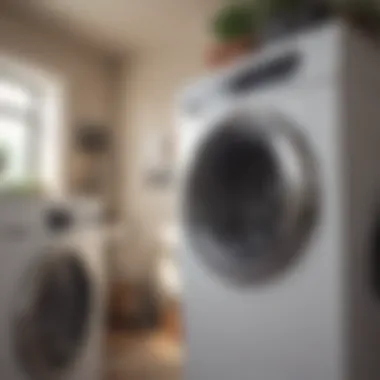
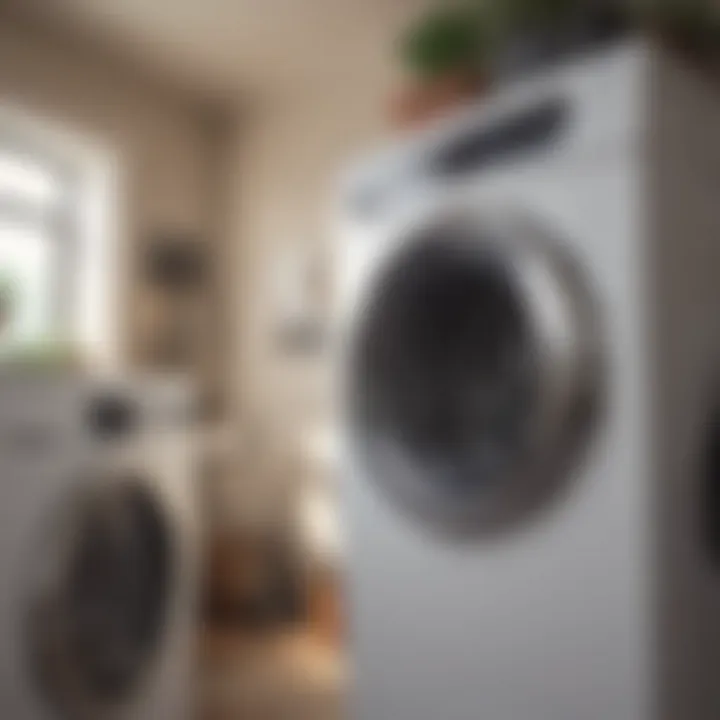
Professional Services
In the realm of home maintenance, sometimes the most prudent choice is to call in the professionals. The importance of professional dryer vent cleaning services cannot be overstated. While there are numerous DIY methods to tackle clogs and lint buildup, the expertise and specialized tools that professionals bring to the table often yield results that far exceed what the average homeowner can achieve. These trained technicians possess a depth of knowledge about the complexities of dryer vents, from installation best practices to the potential hazards of neglect.
Engaging a professional service not only ensures thorough cleaning but also checks for other issues that may contribute to a dryer vent’s inefficiency. For example, improper vent installation or damage that may not be visible to the naked eye. Having an expert assess your system can identify problems that could lead to bigger headaches down the road. Moreover, professionals are familiar with local building codes and safety regulations, ensuring that your vent system not only operates effectively but within legal parameters.
When to Seek Help
Identifying when to call in professionals for dryer vent maintenance can save homeowners both time and money. Here are some signs that suggest it might be time for expert assistance:
- Frequent overheating of the dryer.
- Long drying cycles, taking more than one cycle to dry clothes.
- A noticeable burning smell during operation.
- Excessive lint accumulation around the dryer and vent outlets.
- Visible mold or a musty odor coming from the vent discharge.
- If the vent has never been cleaned or it’s been over a year since the last professional cleaning.
Addressing these issues promptly with a professional can help prevent further damage to your dryer and maintain its efficiency, keeping you in the clear.
Choosing a Service Provider
Selecting the right service provider for dryer vent cleaning can seem overwhelming with choices available. However, paying attention to a few key factors can lead you to a reliable and competent technician:
- Experience and Qualifications: Look for a provider with a solid track record in dryer vent cleaning. Ask about their experience with similar home setups and any certifications they hold.
- Reviews and References: Online reviews can provide insight into the quality of service they offer. Websites like Reddit or local Facebook groups often have discussions about local service providers. Don’t hesitate to ask friends and family for recommendations as well.
- Insurance and Guarantees: Ensure they are insured to protect against any damages during cleaning. A reputable company should also provide a satisfaction guarantee, ensuring that they will return if you encounter issues after their service.
- Comprehensive Service: Check that their service includes a thorough inspection of the entire vent system, not just a simple cleaning. A good provider would also be versed in identifying related issues that may affect performance.
- Cost Transparency: Reputable companies will offer a clear estimate before work begins. Avoid those who provide vague quotes or do not break down costs.
Approaching professional services in this systematic way can help ensure that your dryer vent is cleaned effectively, enhancing its overall efficiency and extending its lifespan. The right choice can transform dryer vent maintenance from a daunting task into a seamless experience.
Legal and Insurance Considerations
Navigating the legal and insurance landscape surrounding dryer vents is crucial for homeowners. This section outlines the key responsibilities that come with homeownership and the implications they carry regarding insurance.
Homeowner Responsibilities
As a homeowner, there are several duties to keep in mind when it comes to maintaining your dryer vent. Failing to address clogs and other issues can lead to serious ramifications. Here’s a rundown of your obligations:
- Routine Maintenance: It's essential to develop a schedule for cleaning your dryer vent. Preventing lint build-up not only ensures efficiency but also avoids potential hazards.
- Adherence to Codes: Different areas have varying building codes regarding dryer vent installation and maintenance. Familiarize yourself with these, as they serve to protect both your home and its occupants.
- Prompt Repairs: If you notice any unusual signs—like excessive heat or strange odors—address them immediately. Ignoring these can escalate to larger problems.
Being diligent about these responsibilities prevents damage to your home and keeps your insurance valid.
Insurance Implications
Insurance policies often include specific clauses related to home maintenance, including dryer vent care. If a fire or damage occurs due to negligence in maintaining your dryer vent, it could impact your coverage. Here’s what’s important to note:
- Fire Risks: Since clogged dryer vents are a leading cause of household fires, your insurance may cover damages if you can prove you've maintained the vent properly. Not having documents or records of upkeep might mean that you pay out of pocket.
- Documentation: Keeping paperwork related to inspections and maintenance is wise. Some insurance companies may ask for these records when processing a claim concerning fire or damage.
- Coverage Limitations: Be aware of the limitations in your policy. Certain insurance plans might not cover damages resulting from neglect or avoided maintenance tasks.
"Regular maintenance not only protects your home from potential damages but also keeps your insurance policy intact."
The Environmental Impact
In our quest to maintain a functioning household, the environmental implications of our appliances often slip quietly into the background. When it comes to dryer vents, neglecting them not only affects efficiency but also has broader environmental repercussions. Understanding these impacts can motivate homeowners not just to keep their systems clean but also to consider their role in sustainable living.
Energy Consumption
First things first, the connection between clogged dryer vents and energy consumption cannot be overlooked. When lint accumulates within the vent, it restricts airflow, leading the dryer to work harder to expel moisture. This added strain translates to increased energy use. You might not notice it immediately, but over time, those higher utility bills add up.
Moreover, according to the U.S. Department of Energy, a well-maintained dryer could save approximately $18-$25 a month in energy costs, depending on usage. Look at it this way: with every cycle, you’re using extra energy that could easily be avoided with regular maintenance. Think of it as pouring money down the drain; if you’re able to save energy, you’re also benefiting the environment by reducing your carbon footprint. Each time you run a dryer, you’re consuming energy that contributes to pollution.
"Regular maintenance isn't just about keeping the appliance running; it's part of a larger conversation about energy efficiency and environmental responsibility."
Waste Considerations
Then there's the waste factor, another critical element often sidelined in these discussions. A clogged dryer vent leads to more than just inefficient cycles. It can cause garments to be washed more frequently or even discarded when deemed unsalvageable due to damage from excessive heat.
Additionally, the lint produced during washing and drying is often overlooked. When it collects in the vent, it inevitably has to be disposed of. Regularly maintaining your dryer vent not only minimizes this waste but also encourages responsible disposal practices. Here are some key points to consider:
- Reducing Textile Waste: Ensure your clothes last longer by preventing damage caused by overheating.
- Lint Disposal: Instead of sending lint to the landfill, consider composting it or using it for craft projects.
- Appliance Lifespan: Regular care extends the life of your dryer, influencing manufacturing waste and the lifecycle impact of appliances.
Being conscientious about the environmental impact of your dryer vent system keeps your home not only cleaner but helps it become greener, too. By focusing on these areas, we can effectively streamline our home management while contributing positively to the planet.
Culmination
In wrapping up this comprehensive guide on unclogging your dryer vent, it�’s vital to underscore the significance of understanding and maintaining this often-overlooked component of your home appliance. A clogged dryer vent doesn’t just mean longer drying times; it can lead to a slew of more serious issues, from increased energy costs to the risk of fire. Each homeowner has a responsibility for the upkeep of their ductwork, so proactive care is not merely advisable, it's essential.
Summary of Key Points
To capture the core aspects we've discussed:
- Understanding the Importance: Keeping your dryer vent clear enhances efficiency and promotes safety.
- Identifying Clogs: Regular monitoring for signs such as extended drying times or strange odors can help you catch problems early.
- Unclogging Steps: Following the appropriate procedures can effectively maintain airflow.
- Preventative Measures: Setting a routine for maintenance can save you time and money in the long run.
- Professional Help: Know when it’s time to call in experts—sometimes DIY just won't cut it.
Final Thoughts on Dryer Vent Care
As you've seen, dryer vent care is not just a task on your to-do list; it's an essential part of preserving the integrity of your home. Simple maintenance steps, such as regular cleaning and inspection, can prevent costly repairs and mishaps. Given the myriad responsibilities homeowners juggle, it can be tempting to skip this upkeep.
However, neglecting your dryer vent may lead to serious safety hazards, including risk of fire. Therefore, integrating vent inspections into your home maintenance routine should be a priority. Stay vigilant, keep an eye on performance, educate yourself, and don’t shy away from reaching out to professionals when necessary. By doing so, you create a safer and more efficient home environment.



